
Home » Speciality Dyes and Biological Stains » Tartrazine
What is Tartrazine?
Tartrazine, also commonly referred to as FD&C Yellow 5, is an organic trisodium salt of tartrazine acid. It is an anionic, hydrophilic azo dye. It is also known as Yellow 5 Lake, Acid Yellow 23 and Food Yellow 4. It is a commonly used food colorant with a E number E102.
| PRODUCT SPECIFICATIONS | |
|---|---|
| Name of Product | Tartrazine |
| IUPAC Name | trisodium;5-oxo-1-(4-sulfonatophenyl)-4-[(4-sulfonatophenyl)diazenyl]-4H-pyrazole-3-carboxylate |
| Synonyms | Acid yellow 23; Yellow 5; Food Yellow 4; Aizen tartrazine; FD&C Yellow No. 5; Yellow 5 Lake; Tartraphenine; Tartran Yellow; Amacid Yellow T; Cilefa Yellow T |
| CAS No | 1934-21-0 |
| Molecular Formula | C16H9N4Na3O9S2 |
| Molecular Weight | 534.4 g/mol |
| Color Index No | 19140 |
| Pubchem CID | 164825 |
| Pubchem SID | 475775547 |
CHEMICAL PROPERTIES
| SR. No | Criteria | Limit/Specification |
|---|---|---|
| 1 | Appearance (form) | Solid Powder |
| 2 | Appearance (color) | Bright Orange to Yellow |
| 3 | Melting Point | > 300°C |
| 4 | Solubility | Soluble in Water (20 g/100 mL) Soluble in Glycerol (18 g/100 mL) Negligibly soluble in Ethanol (0.8 mg/mL) |
| 5 | Log P | log Kow = -10.17 (estimated) |
| 6 | UV-vis (λmax) | 425 nm |
| 7 | Decomposition | When heated to decomposition it emits very toxic fumes of nitrogen, sulfur and sodium oxide |
Uses
- Tartrazine is a commonly used food colorant all over the world. It is found in varying proportions in many food items such as desserts and confectionery items, snacks, beverages, condiments and spreads and other processed foods.
- Various pharmaceuticals (including vitamins, antacids, cold remedies, and other prescription drugs) contain tartrazine to impart a yellow, orange, or green color to the liquid, capsule, pill, lotion, or gel, primarily for identification purpose.
- It is also present in a variety of cosmetics and personal care products, including soaps, hand sanitizers, lotions, shampoos, fragrances, eyeshadow, blush, face powder, nail polish, and other similar items.
- Other goods, such as home cleaners, pet foods, crayons, writing instrument inks, stamp colors, face paints, envelope glues, and deodorants, may also contain tartrazine.
Side effects
- Tartrazine has been reported to trigger allergic reactions in people who suffer from asthma and those who have an intolerance to aspirin.
- Tartrazine, along with a number of other food colorings, can lead to hyperactivity and other symptoms of ADHD in children. However, there is insufficient evidence to support this assertion.
- According to a study that was conducted in 2015, Tartrazine (FD&C Yellow 5) was discovered to cause harm to white blood cells, which may promote the growth of tumors and diseases like cancer are more likely to occur.
FAQs
Q. Where does tartrazine come from?
Tartrazine is a synthetic yellow food dye. It is one of numerous azo food dyes derived from petroleum products.
Q. Is tartrazine bad for you?
Tartrazine is only harmful to certain individuals; not everyone is affected by it or reacts to it, and there is no method to determine how sensitive an individual is to it.
Q. Why is tartrazine banned?
Countries like Sweden, Switzerland, Norway and Austria have banned the use of Tartrazine due to it’s potential to cause anaphylactic (severe allergy) reactions.
Resources
Food Dyes | An overview of all the dyes currently used in Food
Buy high purity Tartrazine from the leading manufacturer with ISO certification. For buying, send us an enquiry-
